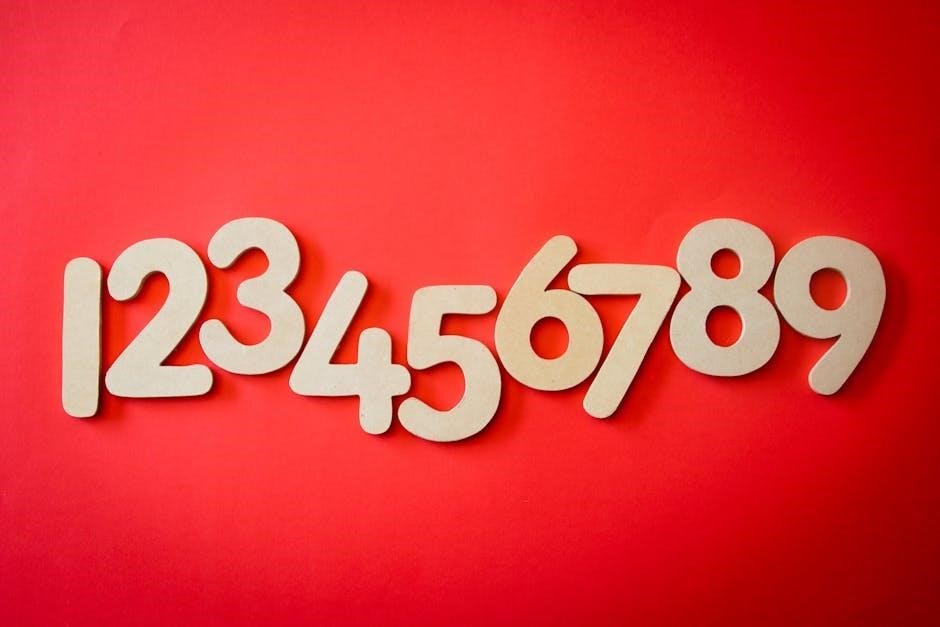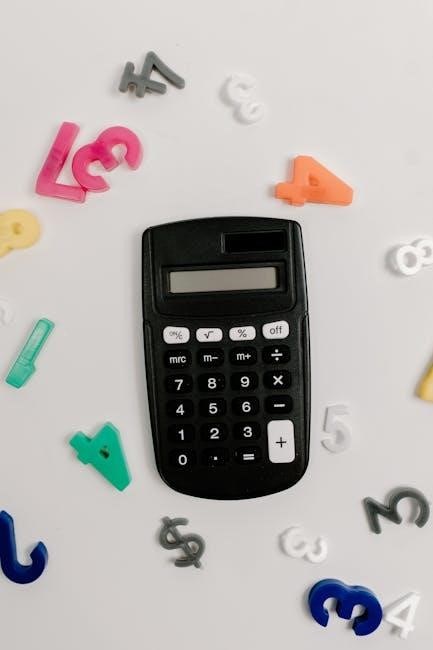These worksheets are designed to help students master multiplying two-digit numbers by two-digit numbers using methods like the grid technique and column multiplication. They provide structured practice.
1.1 Definition and Purpose
2-digit by 2-digit multiplication worksheets are educational tools designed to help students practice multiplying two-digit numbers by two-digit numbers. These resources typically include a variety of problems, often presented in column form or grid methods, and provide space for students to show their work. The primary purpose of these worksheets is to build fluency, confidence, and problem-solving skills in multiplication, serving as a structured and organized way to master this fundamental math concept.
1.2 Importance of Practice in Multiplication
Regular practice with 2-digit by 2-digit multiplication worksheets is crucial for developing mathematical fluency and accuracy. These exercises help students build a strong foundation in multiplication, essential for advanced arithmetic and real-world problem-solving. Consistent practice enhances speed, reduces errors, and boosts confidence, making it easier to tackle more complex math concepts in the future. Worksheets provide a structured and engaging way to reinforce multiplication skills through repetition and variety.

Structure of 2-Digit by 2-Digit Multiplication Worksheets
These worksheets typically include vertical and horizontal problem setups, column forms, grid methods, space for work, and answer keys. They are designed to be clear and organized, helping students systematically approach each multiplication problem. The structured layout ensures that students can easily follow the steps of the multiplication process, making learning more effective and efficient. Additionally, the inclusion of various methods caters to different learning styles, providing a comprehensive practice experience.
2.1 Vertical vs. Horizontal Problem Setup
Worksheets often present problems in either vertical or horizontal formats. Vertical setups align numbers by place value, simplifying column multiplication. Horizontal layouts arrange numbers side by side, resembling real-world equations. Both formats help students understand multiplication structure. Vertical is ideal for column methods, while horizontal mimics standard equation formatting. This dual approach caters to different learning preferences, ensuring students grasp multiplication fundamentals effectively. The varied presentation keeps practice engaging and comprehensive.
2.2 Column Form and Grid Method
Worksheets often feature column form and grid methods to aid multiplication. The column method involves multiplying each digit and adding partial products, while the grid method breaks numbers into tens and units, making calculations visual. These structured approaches help students organize their work, reduce errors, and understand place value. Both methods are widely used and provide a clear framework for solving two-digit multiplication problems effectively.
2.3 Space for Showing Work
Quality worksheets provide ample space for students to show their calculations, promoting organized problem-solving. Lined areas or designated boxes help students neatly write partial products, reducing errors. This feature allows teachers to review work easily, ensuring understanding. Printable PDFs often include these structured spaces, making it easier for students to follow steps methodically and maintain clarity in their solutions. Properly designed work areas enhance the learning experience.
2.4 Answer Keys and Solutions
Most worksheets include answer keys, providing correct solutions for each problem. These keys enable self-assessment and quick verification of results. Detailed step-by-step solutions are often available, breaking down problems to illustrate proper methods. This feature aids students in identifying mistakes and understanding where they went wrong. Teachers also benefit, as answer keys streamline grading and save time, ensuring efficient feedback. Accurate solutions reinforce learning and build confidence in multiplication skills.

Methods Taught in 2-Digit by 2-Digit Multiplication Worksheets
These worksheets teach the standard algorithm, grid method, and breaking down problems into smaller parts, making multiplication accessible and engaging for students of all learning styles.
3.1 Standard Algorithm (Column Multiplication)
The standard algorithm involves writing numbers vertically and multiplying digit by digit, aligning partial products correctly before summing them. Worksheets often include column setups to guide students in organizing their work systematically. This method emphasizes proper alignment and regrouping, helping students build foundational multiplication skills. Practice with column multiplication reinforces accuracy and fluency, making it a cornerstone of math education for two-digit calculations.
3.2 Grid Method for Visual Learners
The grid method is a visual approach where students split numbers into tens and units, creating a grid to organize partial products. This technique helps break down multiplication into manageable parts, making it easier for visual learners to understand. Worksheets often include pre-drawn grids, guiding students to calculate each section and sum the results. This method enhances problem-solving abilities by providing a clear, structured visual representation of the multiplication process.
3.3 Breaking Down Problems into Smaller Parts
Breaking down multiplication problems into smaller, manageable parts is a key strategy taught in these worksheets. Students learn to decompose numbers into tens and units, simplifying calculations. This approach helps visualize the multiplication process, making it easier to handle complex problems; By focusing on partial products and summing them up, learners gain a clearer understanding and reduce errors. This method is particularly effective for visual learners and those needing structured steps to grasp multiplication concepts effectively.
3.4 Real-World Applications
These worksheets emphasize real-world applications of multiplication, helping students connect math to everyday scenarios. Problems often involve calculating quantities like total costs, distances, or group allocations. By practicing with practical examples, learners develop problem-solving skills applicable to real-life situations. This approach makes multiplication more engaging and relevant, encouraging students to see its value beyond academic exercises. Real-world contexts enhance understanding and motivation, preparing students for future challenges.

Features of 2-Digit by 2-Digit Multiplication Worksheets
These worksheets feature printable PDF formats, editable fields, interactive elements, progressive difficulty levels, and varied problem formats such as puzzles and riddles, ensuring engaging and effective learning.
4.1 Printable and Downloadable PDF Formats
These worksheets are available in convenient PDF formats, making them easy to print or download for offline use. Many are fillable and savable, allowing students to complete them digitally or by hand. The PDFs are compatible with browsers like Chrome and Firefox, ensuring accessibility. Designed for educational purposes, they provide a structured format for practicing 2-digit by 2-digit multiplication, often including answer keys for easy grading and progress tracking. This feature ensures that students and educators can utilize the resources efficiently, both in classrooms and at home, supporting consistent practice and learning. The availability of these PDFs makes them a popular choice for teachers seeking high-quality, ready-to-use materials to help students master multiplication skills. They are also free to download, offering a cost-effective solution for schools and families. The clear layout and organized design of these PDF worksheets make them ideal for visual learners and those who benefit from structured practice. Additionally, the PDFs often include optional features like interactive elements and editable fields, catering to diverse learning needs. Overall, the printable and downloadable PDF formats enhance the usability of these worksheets, making them a versatile tool for multiplication practice. The ability to save and reuse the PDFs ensures that students can revisit problems for reinforcement, while teachers can easily distribute them in digital or printed form. This flexibility makes the PDF worksheets a valuable resource for both in-person and remote learning environments. By providing a reliable and accessible way to practice multiplication, these PDFs play a key role in helping students build confidence and fluency in their math skills. The inclusion of answer keys further streamlines the learning process, allowing for quick feedback and self-assessment. As a result, these PDF worksheets are widely regarded as an essential tool for effective multiplication practice, offering a balance of convenience, structure, and educational value. They are particularly beneficial for students in upper elementary grades, where mastering 2-digit by 2-digit multiplication is a critical milestone in their mathematical development. The PDF format ensures that these resources remain a staple in many educators’ arsenals, providing a dependable way to support student learning and achievement in multiplication. With their ease of use and comprehensive design, these worksheets continue to be a popular choice among teachers and parents seeking to provide engaging and effective math practice for their students.
4.2 Editable Fields for Digital Use
Many worksheets offer editable fields, allowing students to input answers directly in digital formats. This feature enhances interactivity and convenience, making it easier to complete assignments on devices. Editable PDFs can be saved and revisited, promoting organized learning. They are compatible with browsers like Chrome and Firefox, ensuring accessibility. This digital adaptability supports modern learning preferences and reduces paper usage, catering to tech-savvy students and eco-conscious educators alike. The fillable format also enables teachers to distribute and collect work efficiently, streamlining classroom workflows and enhancing the overall learning experience.
4.3 Interactive Elements for Engaged Learning
Interactive elements, such as math riddles, puzzles, and task cards, make learning multiplication engaging. These activities break monotony, fostering a dynamic environment. Worksheets often include games and visual aids like grids, appealing to different learning styles. By incorporating fun tasks, students stay motivated and develop problem-solving skills. Interactive tools also encourage active participation, making the practice sessions more enjoyable and effective, while enhancing retention of multiplication concepts through varied and stimulating exercises.
4.4 Progressive Difficulty Levels
Worksheets often feature progressive difficulty levels, starting with simpler 2-digit multiplication and advancing to more complex problems. This gradual approach helps students build confidence and mastery. Problems may begin with smaller numbers and move to larger ones, introducing regrouping and multi-step calculations. Some worksheets also incorporate varied problem formats, such as puzzles or riddles, to keep learning engaging while reinforcing skills at each stage of development.
4.5 Variety of Problem Formats (e.g., Puzzles, Riddles)
Worksheets often incorporate puzzles, riddles, and task cards to make 2-digit multiplication engaging. These formats challenge students to apply their skills creatively, enhancing problem-solving abilities. Interactive elements like math riddles encourage critical thinking, while puzzles provide a fun way to practice. This variety ensures that learning remains dynamic and caters to different learning styles, making multiplication practice both effective and enjoyable for students.

Benefits for Students
Students gain confidence in their multiplication skills, improve problem-solving abilities, and develop fluency and speed. Worksheets also enhance organizational skills and provide a clear structure for learning.
5.1 Building Confidence in Multiplication Skills
Regular practice with 2-digit by 2-digit multiplication worksheets helps students build confidence in their math abilities. The structured format allows learners to master concepts step-by-step, reducing anxiety. Immediate feedback from answer keys reinforces correct techniques, while space for showing work encourages careful calculation. The grid method and column multiplication provide clear visuals, making complex problems manageable. Over time, consistent practice fosters a sense of accomplishment, improving overall confidence in multiplication skills and problem-solving abilities.
5.2 Improving Fluency and Speed
Engaging with 2-digit by 2-digit multiplication worksheets enhances fluency and speed by providing regular practice. The grid method simplifies complex calculations into clear steps, while answer keys offer immediate feedback. Interactive elements and varied problem formats maintain engagement, encouraging consistent practice. Over time, students develop the ability to solve problems quickly and accurately, solidifying their multiplication skills through repetition and structured learning experiences.
5.3 Enhancing Problem-Solving Abilities
2-digit by 2-digit multiplication worksheets help students develop strong problem-solving skills by introducing various methods like the grid technique and column multiplication. These exercises encourage breaking down problems into manageable steps, fostering logical thinking. With consistent practice, students learn to approach complex calculations with confidence, applying strategies that enhance their ability to solve real-world problems efficiently and accurately.
5.4 Developing Organizational Skills
2-digit by 2-digit multiplication worksheets help students develop organizational skills by providing structured formats for calculations. Features like grids and column setups guide students to arrange numbers and partial products neatly, reducing errors. The clear layout encourages step-by-step problem solving, teaching students to manage complex calculations systematically. This structured approach enhances their ability to organize thoughts and work efficiently, fostering better math habits and clarity in problem solving.

Benefits for Educators
Worksheets provide educators with consistent practice material, saving time in lesson planning. Answer keys simplify grading, while customizable options allow tailoring to classroom needs effectively.
6.1 Time-Saving Resource for Lesson Planning
These worksheets offer educators a ready-to-use resource, eliminating the need to create practice materials from scratch. With pre-designed problems, answer keys, and structured formats, teachers can quickly incorporate them into lesson plans. The availability of printable and downloadable PDFs ensures effortless distribution, while customizable options allow for tailored instruction. This convenience enables educators to focus on teaching strategies rather than material preparation, making lesson planning more efficient and streamlined for classroom success.
6.2 Consistent Practice Material
These worksheets provide educators with consistent practice material, ensuring uniformity in skill development. Regular use of structured PDF formats helps students build fluency and confidence in multiplication. With a variety of problem formats, including vertical and horizontal setups, puzzles, and riddles, these resources keep learning engaging. The availability of answer keys and downloadable options makes them a reliable tool for educators, ensuring students receive regular and effective practice opportunities to master two-digit multiplication skills.
6.3 Easy Grading with Answer Keys
Worksheets often include answer keys, making grading straightforward and efficient for educators. These keys provide correct solutions, allowing teachers to quickly assess student performance and identify areas needing improvement. The consistency of answer keys ensures accuracy and fairness in grading, saving valuable time for educators. This feature is particularly useful for managing large classrooms or balancing multiple responsibilities, as it streamlines the grading process and supports effective student feedback.
6.4 Customization Options
Many 2-digit by 2-digit multiplication worksheets offer customization options, allowing educators to tailor resources to specific classroom needs. Editable fields enable teachers to adjust problems or add instructions, while downloadable PDFs can be modified to suit different learning levels. Some worksheets also include interactive elements or varied problem formats, such as puzzles or riddles, to keep students engaged. This flexibility ensures that educators can efficiently adapt materials to meet diverse student requirements and teaching strategies.

Where to Find High-Quality Worksheets
High-quality 2-digit by 2-digit multiplication worksheets can be found on recommended websites, educational apps, and community-shared resources, ensuring accessibility and convenience for educators and students.
7.1 Recommended Websites and Platforms
Several websites offer high-quality 2-digit by 2-digit multiplication worksheets. Math-Drills.com provides free, downloadable PDFs with various problem formats. K5Learning.com offers printable worksheets with column multiplication practice. Additionally, platforms like Education.com and Teachers Pay Teachers feature interactive and customizable resources. These sites cater to different learning styles, offering both traditional and engaging formats like puzzles and riddles to make practice enjoyable and effective for students.
7.2 Educational Apps with Printable Resources
Educational apps like Khan Academy Kids and Math Games offer printable 2-digit multiplication worksheets. These apps provide interactive drills and exercises, which can be downloaded as PDFs for offline practice. Photomath and Brainly also offer customizable templates and step-by-step solutions, making learning engaging and accessible. These tools are ideal for both students and educators, ensuring a seamless transition between digital and traditional learning methods while maintaining structured practice routines.
7.3 Community-Shared Resources
Community-shared resources are a valuable source for 2-digit multiplication worksheets. Websites like Math-Drills.com and K5Learning offer free, downloadable PDFs. Teachers and educators often share their custom-designed worksheets on platforms like Teachers Pay Teachers. These resources are frequently updated and cater to diverse learning needs, providing a collaborative space for educators and students to access high-quality materials. This collective sharing ensures a wide variety of practice options for mastering multiplication skills effectively.

Tips for Using Worksheets Effectively
Incorporate worksheets into daily routines and lesson plans, encouraging regular practice and interactive learning with digital tools to enhance engagement and understanding of multiplication concepts.
8.1 Setting Up a Regular Practice Routine
Establishing a consistent practice routine is essential for mastering two-digit multiplication. Dedicate 10-15 minutes daily to work through worksheets, starting with simpler problems and gradually increasing difficulty. Use printable PDFs to ensure accessibility and convenience. Begin with problems that align with current skill levels, then introduce more challenging ones as confidence grows. Incorporate the grid method for visual learners and standard algorithms for others. Set specific goals for each session and celebrate progress to maintain motivation and engagement.
8.2 Incorporating Worksheets into Lesson Plans
Incorporate 2-digit by 2-digit multiplication worksheets into lesson plans by using them as supplements to direct instruction. Start with a brief review of the multiplication method, then distribute the worksheets for guided practice. Use the grid method for visual learners and standard algorithms for others. Interactive elements like puzzles and riddles can make lessons engaging. Ensure worksheets align with current curriculum goals and adjust difficulty based on student progress. These resources support differentiated instruction and reinforce classroom learning effectively.
8.3 Encouraging Peer Review and Collaboration
Encourage students to review each other’s worksheets and collaborate on solving problems. Pair students to discuss strategies, such as the grid method or column multiplication, fostering teamwork and understanding. This approach helps identify common mistakes and improves communication skills. Educators can create group activities where students explain their solutions, promoting a supportive learning environment and enhancing problem-solving through shared insights and feedback. Peer collaboration strengthens conceptual understanding and confidence in multiplication skills.
8.4 Using Digital Tools for Interactive Learning
Digital tools enhance engagement by offering interactive 2-digit multiplication practice. Worksheets with fillable fields allow students to input answers directly, while features like real-time feedback and progress tracking motivate learners. Interactive elements, such as drag-and-drop problems or animated tutorials, make practice more dynamic; Digital platforms also enable teachers to assign and review work efficiently, fostering a blend of technology and traditional learning. These tools cater to different learning styles, ensuring an inclusive and effective educational experience for all students.

Common Mistakes to Avoid
Common errors include misalignment in column multiplication, forgetting to regroup, incorrect placement of partial products, and rushing through problems without proper alignment or careful calculation.
9.1 Misalignment in Column Multiplication
Misalignment in column multiplication is a frequent error. Students often misplace numbers, causing incorrect partial products. Proper alignment ensures digits are correctly positioned under one another. Using guiding lines or grids helps maintain order, preventing this mistake. Regular practice and careful review of work can significantly reduce misalignment issues and improve overall multiplication accuracy.
9.2 Forgetting to Regroup
Forgetting to regroup is a common mistake in multiplication. When multiplying, students often overlook carrying over extra digits to the next column. This oversight leads to incorrect partial products and final answers. Emphasizing regrouping steps and using visual aids like grids or lines can help students remember this critical process. Regular practice with detailed steps ensures regrouping becomes second nature, improving overall multiplication accuracy and fluency.
9.3 Incorrect Placement of Partial Products
Misplacing partial products is a frequent error in two-digit multiplication. Students often fail to align the partial products correctly beneath the appropriate columns, leading to incorrect sums. This mistake stems from poor organization or rushing through calculations. Using grid methods or column alignment tools can help students position partial products accurately. Emphasizing neatness and proper alignment during practice reduces this error, ensuring the final sum is calculated correctly and efficiently.
9.4 Rushing Through Problems
Rushing through multiplication problems often leads to careless mistakes, such as misalignment of numbers or incorrect regrouping. Students may skip steps or overlook details, resulting in inaccurate answers. Encouraging a steady pace and emphasizing the importance of each step can help reduce errors. Incorporating timed drills and positive reinforcement for careful work fosters better habits and improves overall accuracy in solving two-digit multiplication problems.

Tracking Progress
Tracking progress involves setting milestones, identifying areas needing attention, and celebrating improvements. Regular review of worksheets helps monitor student growth and ensures consistent practice for mastery of two-digit multiplication.
10.1 Setting Milestones and Goals
Setting clear milestones and goals helps students stay focused and motivated. Break down the multiplication process into manageable steps, such as mastering the grid method or column multiplication. Establishing specific targets, like completing a set of problems accurately within a timeframe, allows for measurable progress. Regularly reviewing these goals ensures students stay on track and build confidence in their abilities. This structured approach fosters a sense of accomplishment and encourages consistent practice.
10.2 Using Worksheets to Identify Weak Areas
Worksheets are invaluable for identifying areas where students struggle with 2-digit by 2-digit multiplication. By analyzing incorrect answers, teachers and parents can pinpoint specific challenges, such as misalignment in columns or regrouping errors. Regular use of these worksheets helps track progress and highlights patterns of mistakes, enabling targeted practice and improvement. This feedback loop ensures students address weaknesses effectively, leading to better mastery of multiplication skills over time.
10.3 Celebrating Improvements
Celebrating improvements in multiplication skills boosts students’ confidence and motivation. Recognizing progress, no matter how small, encourages a growth mindset. Teachers and parents can highlight achievements through verbal praise, reward systems, or sharing successes with peers. This positive reinforcement helps students stay engaged and motivated to continue practicing. Celebrating milestones also reinforces the value of hard work and perseverance, fostering a love for learning and improving multiplication fluency over time.
Mastering 2-digit by 2-digit multiplication is achievable with consistent practice using worksheets. These resources provide a clear path to improving skills, building confidence, and ensuring accuracy.
11.1 Summary of Key Points
2-digit by 2-digit multiplication worksheets are essential tools for developing math skills. They offer structured practice, introducing methods like column multiplication and the grid technique. These resources help build fluency, confidence, and problem-solving abilities. Worksheets are available in PDF formats, often featuring answer keys for easy grading. Regular practice with these materials ensures mastery of multiplication, preparing students for more complex math challenges while reinforcing foundational skills.
11.2 Final Thoughts on the Importance of Practice
Consistent practice with 2-digit by 2-digit multiplication worksheets is crucial for mastering this skill. Regular use of these resources builds confidence, fluency, and accuracy. By incorporating worksheets into daily routines, students can reinforce their understanding and develop a strong foundation for more complex math concepts. The availability of PDF formats and interactive tools makes it easier for learners to engage and improve their multiplication skills effectively.

